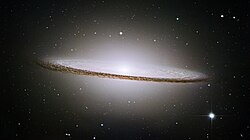קובץ:Sombrero Galaxy in infrared light (Hubble Space Telescope and Spitzer Space Telescope).jpg

גודל התצוגה המקדימה הזאת: 800 × 448 פיקסלים. רזולוציות אחרות: 320 × 179 פיקסלים | 640 × 359 פיקסלים | 1,024 × 574 פיקסלים | 1,280 × 717 פיקסלים | 3,000 × 1,681 פיקסלים.
לקובץ המקורי (3,000 × 1,681 פיקסלים, גודל הקובץ: 3.98 מ"ב, סוג MIME: image/jpeg)
היסטוריית הקובץ
ניתן ללחוץ על תאריך/שעה כדי לראות את הקובץ כפי שנראה באותו זמן.
| תאריך/שעה | תמונה ממוזערת | ממדים | משתמש | הערה | |
|---|---|---|---|---|---|
| נוכחית | 23:46, 20 ביולי 2009 |  | 1,681 × 3,000 (3.98 מ"ב) | Tryphon | {{Information |Description=NASA/ESA Hubble Space Telescope and NASA's Spitzer Space Telescope joined forces to create this striking composite image of one of the most popular sights in the universe. Messier 104 is commonly known as the Sombrero galaxy bec |
שימוש בקובץ
הדפים הבאים משתמשים בקובץ הזה:
שימוש גלובלי בקובץ
אתרי הוויקי השונים הבאים משתמשים בקובץ זה:
- שימוש באתר ast.wikipedia.org
- שימוש באתר az.wikipedia.org
- שימוש באתר bs.wikipedia.org
- שימוש באתר cs.wikipedia.org
- שימוש באתר de.wikipedia.org
- שימוש באתר en.wikipedia.org
- שימוש באתר en.wikiquote.org
- שימוש באתר en.wikiversity.org
- שימוש באתר es.wikipedia.org
- שימוש באתר fa.wikipedia.org
- שימוש באתר frp.wikipedia.org
- שימוש באתר fr.wikipedia.org
- שימוש באתר id.wikipedia.org
- שימוש באתר it.wikibooks.org
- שימוש באתר kk.wikipedia.org
- שימוש באתר kn.wikipedia.org
- שימוש באתר mg.wikipedia.org
- שימוש באתר pl.wikipedia.org
- שימוש באתר pt.wikipedia.org
- שימוש באתר simple.wikipedia.org
- שימוש באתר sk.wikipedia.org
- שימוש באתר sv.wikipedia.org
- שימוש באתר sw.wikipedia.org


